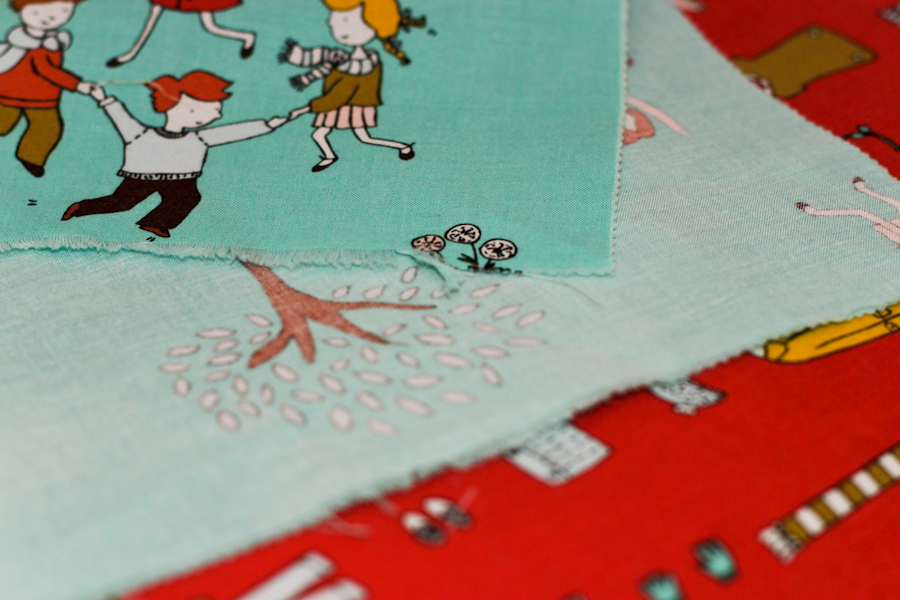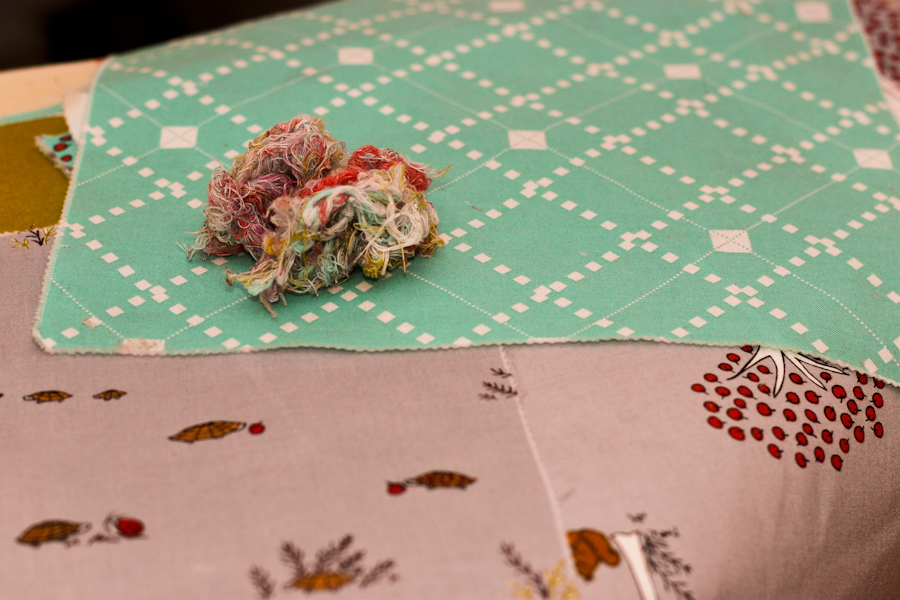I very recently started quilting and one of the first things I had questions about when I finally got my first fabric order was:

The right side of the fabric had minimal fraying, but look at the bottom edge! And the reason this totally sucks is because now my measurements were all off. The once 5"x5" squares now had irregular dimensions which made lining up the seams that more difficult. Most patterns I've come across call for a 1/4" seam allowance and for some of my squares I definitely sewed really close to the edge of the fabric because so much had frayed in the wash. Here's another photo of some of the loose threads that came off during the wash:

My heart kinda suck when I saw all the threads hanging off the fabric squares and clumped together. The ball of thread in the above photo isn't even all the loose threads I found. It was a bit disheartening and the irregular sized squares added additional measuring, cutting, and sewing time. But, since I used most of the fabric for my first personal quilt I can attribute the mismatched seams and points to a beginner's learning curve. But lesson learned......I will never pre-wash my quilting fabrics unless all the fabric in a particular quilt come from large cuts of fabric. The hassles of additional ironing and then having irregular sized pre-cuts were not worth the worry of some shrinkage or color bleeding. And besides, if all the fabric used in a quilt aren't pre-washed, then I think the shrinkage would sorta even out after the first wash....I guess I'll find out the next time I make a quilt!
Should I pre-wash the fabric before quilting?
I so badly wanted to dive right in and start measuring and cutting, but the fabric I bought had lots of red and white and all I could think about is what happens if I don't pre-wash the fabric, I finish my very first quilt, wash it, and then see that all the colors bled? And what if there is shrinkage??? I searched the interwebs for quite some time hoping to find some answers, but some people said do it and others said it didn't matter. I just couldn't decide what to do based on what I had read so I decided to go with my gut. I'm used to sewing clothes and hemming pants and I've always been instructed to pre-wash the fabric before sewing. So......I pre-washed my fabric before I started quilting. And guess what? I'll NEVER DO IT AGAIN!
First of all, I bought one layer cake and two charm packs. If you have no idea what I'm talking about, these are pre-cut fabrics. One layer cake consists of 42 - pre-cut 10"x10" squares of a particular fabric collection. One charm pack consists of 42 - pre-cut 5"x5" squares of a particular fabric collection. (I'll discuss my fabric selection in a separate post.)
Since the charm packs have smaller cuts of fabric I put them in a laundry bag thinking it would somehow 'protect' the fabrics. And I don't know why I was so worried about the colors bleeding in a quilt because I washed all the fabric together, the whites mixed with the greys, turquoise, olive greens, and RED! *gasp* I knew I was in trouble as soon as the wash cycle was done and I transferred the fabric to the dryer. Not because the whites looked pink because in fact they looked perfectly white! But rather: there. was. so. much. fraying. When I finally took the fabric out of the dryer I then had to iron every piece of fabric because they were all so wrinkled! That was an extra step I forgot I would need to do and a huge pain the behind. But the fraying I mentioned earlier? Here's what I'm talking about:

The right side of the fabric had minimal fraying, but look at the bottom edge! And the reason this totally sucks is because now my measurements were all off. The once 5"x5" squares now had irregular dimensions which made lining up the seams that more difficult. Most patterns I've come across call for a 1/4" seam allowance and for some of my squares I definitely sewed really close to the edge of the fabric because so much had frayed in the wash. Here's another photo of some of the loose threads that came off during the wash:

My heart kinda suck when I saw all the threads hanging off the fabric squares and clumped together. The ball of thread in the above photo isn't even all the loose threads I found. It was a bit disheartening and the irregular sized squares added additional measuring, cutting, and sewing time. But, since I used most of the fabric for my first personal quilt I can attribute the mismatched seams and points to a beginner's learning curve. But lesson learned......I will never pre-wash my quilting fabrics unless all the fabric in a particular quilt come from large cuts of fabric. The hassles of additional ironing and then having irregular sized pre-cuts were not worth the worry of some shrinkage or color bleeding. And besides, if all the fabric used in a quilt aren't pre-washed, then I think the shrinkage would sorta even out after the first wash....I guess I'll find out the next time I make a quilt!
[...] I pre-washed these pieces so even though they started their lives as 5″x5″ squares, they got distorted in the washing and drying cycle. I wanted the finished blocks to be 4″x4″ so I think I did some slight [...]
ReplyDelete